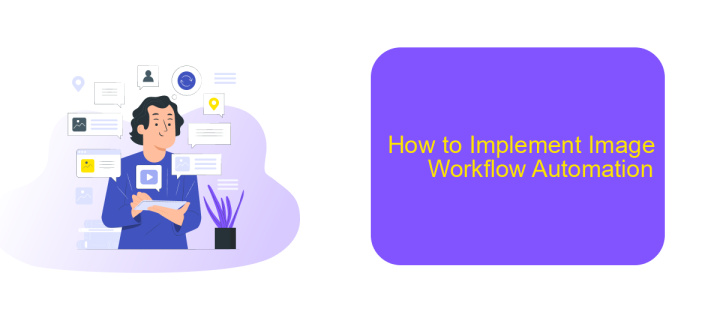Image Workflow Automation
In today's digital age, efficient image management is crucial for businesses and creative professionals alike. Image Workflow Automation streamlines the process of editing, organizing, and distributing images, saving time and reducing human error. By leveraging advanced algorithms and AI, this technology enhances productivity and ensures high-quality results, allowing teams to focus on creativity and strategic tasks.
Introduction
Image Workflow Automation is a transformative approach to managing and processing images efficiently. By automating repetitive tasks, businesses can save time, reduce errors, and ensure consistency in their image-related workflows. This process involves various stages, including image acquisition, editing, storage, and distribution, all streamlined through automation tools.
- Automated image acquisition from multiple sources
- Batch processing for consistent editing and enhancements
- Efficient storage solutions with automated tagging and categorization
- Seamless distribution across various platforms
Integrating these automated workflows with existing systems can be challenging. Services like ApiX-Drive facilitate this integration by connecting different applications and automating data transfers, ensuring a smooth and efficient workflow. By leveraging such tools, businesses can enhance their productivity and maintain high-quality standards in their image management processes.
Benefits of Image Workflow Automation

Image workflow automation significantly enhances productivity by streamlining repetitive tasks, allowing teams to focus on more creative and strategic activities. By automating processes such as image resizing, format conversion, and metadata tagging, organizations can ensure consistency and accuracy across their digital assets. This not only reduces the risk of human error but also accelerates project timelines, leading to faster time-to-market for visual content.
Furthermore, integrating automation tools with existing software ecosystems can simplify complex workflows. Services like ApiX-Drive facilitate seamless integration between various applications, enabling automated data transfers and process synchronization. This ensures that all team members have access to the most up-to-date images and related information, fostering better collaboration and decision-making. Ultimately, image workflow automation not only boosts efficiency but also enhances the overall quality and effectiveness of visual content management.
Common Use Cases

Image workflow automation is a powerful tool that can streamline various processes, saving both time and resources. It is particularly beneficial in industries where large volumes of images need to be processed, edited, or analyzed regularly.
- E-commerce: Automate the process of resizing, watermarking, and optimizing product images for faster website loading times and better user experience.
- Marketing: Streamline the creation of social media graphics, ensuring consistent branding and timely posting across multiple platforms.
- Real Estate: Automatically enhance property photos, including adjustments for lighting and color correction, to create more appealing listings.
- Healthcare: Process and analyze medical images for quicker diagnostics and treatment planning.
- Media and Publishing: Simplify the editing and categorization of images for articles, ensuring they meet publication standards.
Services like ApiX-Drive can further enhance image workflow automation by integrating various tools and platforms. This allows for seamless data transfer and process synchronization, ensuring that all parts of the workflow are efficiently managed. By leveraging such integrations, businesses can significantly improve their operational efficiency and reduce manual workload.
How to Implement Image Workflow Automation

Implementing image workflow automation can significantly enhance efficiency and consistency in managing visual content. To start, it's crucial to analyze your current workflow and identify repetitive tasks that can be automated. This initial assessment will help you pinpoint areas where automation can have the most impact.
Next, choose the right tools and platforms that support image workflow automation. Look for solutions that offer robust features like batch processing, automatic resizing, and format conversion. Additionally, consider services like ApiX-Drive, which can facilitate seamless integration between different applications, ensuring that your automated workflow is both comprehensive and cohesive.
- Analyze your current image workflow
- Select appropriate automation tools
- Utilize integration services like ApiX-Drive
- Test and refine your automated processes
Finally, continuously monitor and optimize your automated workflows. Regularly review performance metrics to identify any bottlenecks or areas for improvement. By staying proactive, you can ensure that your image workflow automation remains effective and scalable as your business needs evolve.
Conclusion
In conclusion, Image Workflow Automation significantly enhances efficiency and accuracy in managing visual content. By automating repetitive tasks, teams can focus on more creative and strategic initiatives, leading to improved productivity and better quality outcomes. The integration of advanced tools and technologies ensures that image processing is consistent, timely, and scalable, meeting the demands of various industries.
Additionally, leveraging services like ApiX-Drive can streamline the integration process, allowing seamless connectivity between different platforms and applications. This not only simplifies the workflow but also reduces the potential for errors and delays. As organizations continue to adopt automation solutions, the ability to integrate and scale these systems will be crucial for maintaining a competitive edge. Ultimately, Image Workflow Automation represents a vital step towards modernizing content management practices and achieving operational excellence.


FAQ
What is Image Workflow Automation?
How can I implement Image Workflow Automation in my business?
What are the benefits of using Image Workflow Automation?
Can Image Workflow Automation handle multiple image formats?
How do I ensure the security of my images during the automation process?
Apix-Drive is a simple and efficient system connector that will help you automate routine tasks and optimize business processes. You can save time and money, direct these resources to more important purposes. Test ApiX-Drive and make sure that this tool will relieve your employees and after 5 minutes of settings your business will start working faster.

